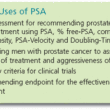Two Recent PSA Screening Studies
The European Randomized Study of Screening for Prostate Cancer (ERSPC) reported that men who were assigned to be screened had a 20% lower death rate from prostate cancer than men not assigned to be screened. However, screening carried a high risk for over-diagnosis, and a large number of men would have to be screened and treated to save one life.
The trial from the United States (Prostate, Lung, Colorectal and Ovarian Cancer Screening Trial [PLCO]) reported that screening with a PSA cutoff of 4 ng/ml and prostate examination did not decrease the death rate from prostate cancer.
Unfortunately, the media coverage generally summarized these studies together as showing that screening for prostate cancer saves few, if any, lives and does more harm than good
These reports have led to confusion among the public and distress among many prostate cancer patients. The unbalanced media coverage will scare many men away from potentially life-saving PSA testing and prostate cancer treatment
Questions From the Study
The questions I have been most commonly asked are: (1) Does PSA testing save lives or not? (2) Does PSA testing do more harm than good? (3) Has my prostate cancer been over-diagnosed and over-treated? (4) What do you recommend for PSA screening?
My responses are as follows:
Does PSA testing save lives or not?
PSA testing has saved many thousands of lives and could save far more if performed intelligently and combined with prompt, effective, high-quality treatment.
What is the evidence for saving lives?
Compelling evidence comes from the cancer registries of the U.S. and the World Health Organization data bases.
The percentage of men who have advanced prostate cancer at the time it is diagnosed has decreased by 75% in the U.S. during the PSA era (more than for any other tumor), and in the European screening study, there was more than a 40% decrease in advanced disease at diagnosis.
In the U.S. cancer registry, as of October 27, 2008, the decrease in the prostate cancer death rate is 37% during the PSA screening era, more than for any other cancer in men or women.
Other studies have shown that in regions of the U.S. where there is more PSA testing, there is a lower rate of advanced prostate cancer and prostate cancer deaths. Globally, death rates also have fallen in countries where PSA testing is practiced and continue to rise in countries where it is not.
Why hasn’t the cancer registry evidence been accepted as proof of the benefits of prostate cancer screening?
The reason is that the “holy grail” of evidence-based medicine is a prospective, randomized clinical trial. However, it is important to point out that a poorly planned and executed clinical trial, such as the PLCO trial may also produce misleading results. The PLCO trial is fatally flawed.
The media coverage of the two screening trials failed to adequately address their relative strengths and weaknesses.
In the aftermath of the confusion caused by the media coverage of these contradictory studies, Dr. John Barry, President of the American Urological Association (AUA) wrote to member urologists,
“It is the opinion of the AUA that the PSA test is a valuable screening tool that saves lives… In the other (European) study, there was actually a 20 percent reduction in death from prostate cancer with a relatively short follow-up of only nine years. This is an important point. The benefit of screening may not be demonstrable until significantly longer follow up is reached for both trials.”
Does PSA testing do more harm than good?
To address this issue, Dr. Barry, wrote:
Multiple experts have weighed in on the two most recent studies and agree that neither clearly asserts that PSA testing causes more harm than benefit. It is the opinion of the AUA that the PSA test is a valuable screening tool that saves lives – and men with concerns about elevated PSA scores should consult their urologists about next steps.
The goal in screening is to detect prostate cancer that could cause suffering or death, and treatment of such cancers is necessary if screening is to be beneficial. Intelligent screening selects appropriate candidates who will benefit from high-quality, effective treatment to prevent suffering and death.
Has my prostate cancer been over-diagnosed and over-treated?
Prostate cancer arises silently and remains silent in a curable state for a variable length of time before silently passing into an incurable stage. Thus, by the time prostate cancer causes symptoms, it is usually incurable.
Since there is no effective means of prevention and no cure for advanced disease, early detection and appropriate, effective treatment are the only practical means of reducing prostate cancer death rates.
To detect prostate cancer early, screening is required. To be effective, screening must detect cancers at an earlier stage and, therefore, create lead-time. Lead-time virtually always results in some over-detection.
Thus, any effort to detect cancer early will involve detection of cancers that might not have been detected without proactive PSA testing. Therefore, some over-detection is necessary to reduce suffering and death from prostate cancer.
How big an issue is over diagnosis and over treatment and how can one tell whether an individual patient is being over-diagnosed and over-treated? There are no clear-cut answers.
There are two methods of estimating over-diagnosis. The first applies only to populations, not to individuals. With this method, statisticians look at population trends in prostate cancer cases and use statistical models to estimate whether more cases are being diagnosed than should be, considering past incidence rates of prostate cancer and prostate cancer deaths.
However, published criteria for over-diagnosis differ. For example, some consider a cancer over-diagnosed if it would not have been diagnosed during the patient’s lifetime. Others consider an over-diagnosed cancer one that would not cause suffering or death. But how can anyone really know?
The second method of estimating over-diagnosis is for a pathologist to examine a surgically-removed cancerous prostate gland and determine whether it contained only a tiny amount of cancer with no aggressive-appearing cells and that was completely encapsulated within the prostate gland. If so, they call it an over-diagnosed cancer.
Actually, surgeons and patients alike are delighted when the final pathology report shows such favorable features, because the prognosis is considerably better than when the cancer is larger, has more aggressive cells or has spread to the margins of the prostate gland or beyond.
Unfortunately, it is unknown what the final pathology report will show before a prostate gland has been removed. Morever, even a small cancer with favorable features could potentially be life-threatening in a patient with a life expectancy of more than 10 years. Thus, over-detection may be a larger issue for older men; whereas, in younger men, over-detection is nearly impossible to prove.
In an ABC News Internet article on a study reporting on over diagnosis (March 10, 2009) “Are Prostate Cancer Tests Worth the Trauma?” Audrey Grayson and Dan Childs wrote :
As director of the Clinical Prostate Cancer Program at Northwestern University Feinberg School of Medicine in Chicago, Dr .William Catalonahe has seen his fair share of prostate cancer. And while he acknowledged that a certain level of over diagnosis occurs when it comes to prostate cancer testing, he said the benefits of the test far outweigh the risks of not having it done.
“I think that if [the authors] spent as much time trying to cure prostate cancer patients as I do, they might think again about discouraging efforts at early prostate cancer detection,” Catalona said. “There is little doubt that PSA testing saves lives.”
Grayson and Childs continued:
Dr. Robert Reiter, professor of urology and director of the Prostate Cancer Program for the UCLA Health System, argued that the harms of diagnosing some patients who may not need treatment is far outweighed by the benefit of catching some deadly cancers early.
“The reality is that the goal of early diagnosis will become increasingly relevant for all cancers, in as much as the only way to reduce death from cancer is to diagnose them even earlier,” Reiter said. “There is not nearly as much over diagnosis as these individuals think.”
What do I recommend for screening?
I conducted a large PSA screening study that enrolled 36,000 men and lasted for 12 years.
After the study was completed, my research group evaluated the median PSA value of all the men enrolled in the study in each age decade and related it to the risk of being diagnosed with prostate cancer and of having aggressive-appearing disease.
The median PSA was 0.7 for men in their 40s, 0.9 for men in their 50s, 1.3 for men in their 60s and 1.7 for men in their 70s.
If a man’s PSA was less than the median for his age group, his risk for being diagnosed with prostate cancer was low. If his PSA was above the median, the risk for being diagnosed with prostate cancer was higher than in the general population. The higher the PSA, the greater the risk for cancer and the greater the risk for aggressive disease. It is important that all of these age-specific median PSA values are lower that commonly used PSA cutoffs for screening, such as 4, 3, or 2.5.
The American Cancer Society and the American Urological Association recommend that men at average risk should decide whether or not to be screened based on their own situation and after discussing the benefits and limitations of screening with their doctor.
My recommendation is similar to the National Comprehensive Cancer Center Network guidelines. All men should have an initial PSA at age 40 to determine their risk level.
My research group found that a PSA level at age 40 can be associated with a higher risk for prostate cancer than race or family history of prostate cancer. In men with a family history of early age-at-onset prostate cancer, I recommend that screening begin at an age 10 years younger that that of the youngest family member with prostate cancer. Of note, men younger than age 50 years were not included in the ERSPC or PLCO trials.
Then, I recommend at least annual PSA screening to accumulate data that could be used to detect a rising PSA trend. If the PSA rises persistently by more than 0.3 to 0.4 ng/ml per year, there should be concern that the patient might be developing life-threatening prostate cancer, as studies from Johns Hopkins have correlated this rate of rise in PSA with future prostate cancer-specific death rates. Other studies have also validated the association between PSA velocity with the risk for prostate cancer death; however, serial PSA measurements are necessary in order to evaluate whether a rise has occurred.
If the PSA does not decrease spontaneously or with antibiotic therapy to rule out inflammation in the prostate, I recommend a prostate biopsy.
For patients without a long-term PSA history, I recommend using a PSA cutoff of 2.5 to recommend a biopsy, especially, if the PSA is persistently rising.
I believe this approach will help avoid under-diagnosis, which is still a larger issue than over-diagnosis. Further, I believe the risks of over-diagnosis can be dealt with in most cases by using good clinical judgment in selecting patients for treatment and ensuring that their treatment is high-quality and effective.











